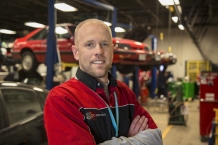Motorcycle Crash Survivor Gets Second Lease on Life at St.Luke's
 Published in the Woman Today Magazine June/July 2017
Published in the Woman Today Magazine June/July 2017
Nick Schaller doesn’t remember anything about his devastating motorcycle crash on October 9, 2015, or the three weeks directly following in the hospital as he began his arduous recovery.
A long-time a fan of motorcyles, Nick was the proud owner of a 2006 Harley- Davidson Electra Glide Standard and a member of the Thunderbird Motorcycle Club.
On that fall day, he and a friend were on the road heading for a bar and grill when Nick went around a corner and ended up in a ditch, hitting a light pole. Sadly, Nick was not wearing a helmet. His friend, who was following him on his own motorcycle, came upon the scene of the crash and called 911.
Nick was rushed to St. Luke’s Regional Trauma Center via ambulance. He sustained a traumatic brain injury (TBI) and was in a coma for a few days. “My friend told me very few details,” Nick says. “I never knew what happened or what the site looked like.”
Working His Way Back
Nick’s injuries included hitting the back of his head, having a spike on his handlebars pierce his thigh, and other abrasions. After being discharged from St. Luke’s Intensive Care Unit, his treatment went into high gear for the brain injury on St. Luke’s Inpatient Rehabilitation Unit (8 West).
“I received really excellent care at 8 West at St. Luke’s. I am told I was a difficult patient at first and kept getting out of bed and setting off the bed alarm, but I don’t remember any of that.” He remained in the rehab unit until November 3, 2015, before going home to continue his recovery and therapy.
“TBI can take at least two years or more to heal, with the initial healing taking six months. Then, after two years, you just adapt with ‘work-arounds’ for whatever has not come back,” Nick explains.
Setting goals for himself included working to get back in the Army National Guard where he was on a medical leave hold following the crash. Nick is an E6 Staff Sergeant and 16-year veteran who had tours in Bosnia (2003-04) and Iraq (2005-07).
“I was bound and determined to make it back in the Guard and was thrilled a year after the accident when I was accepted back. I hope to have at least one more tour,” he says.
In October of 2016, when an opportunity came up at Lake Superior College (LSC), Nick’s experience as a mechanic in the military helped him get a position as a college auto lab assistant working with auto students and LSC staff. He notes, “I love this job and the people I work with, and it has given me a stable position to help put things back together.”
It’s still, though, a day-to-day process to pick up the pieces. Nick adds, “I had been warned about depression and that has been a challenge. And while I had a great memory before, now I have to keep a notebook and write things down. But the main thing I have learned from all of this is resiliency. My strength is that I never give up, and I don’t take for granted that the doctors still call me a miracle.”
A Team Effort
Samuel Laney, MD, is a member of St. Luke's Physical Medicine & Rehab Associates and the medical director of St. Luke's Inpatient Rehabilitation Unit. Dr. Laney has earned a subspecialty certification in Brain Injury Medicine (BIM) and is the only Physical Medicine & Rehabilitation physician north of the Twin Cities who has this subspecialty.
“It’s important with brain injuries to deal with the medical issues, of course, but also with the psychological and emotional aspects. TBI patients often exhibit agitation (akathisia) where restlessness causes them to pace all day. Some patients are combative and will tear their rooms apart. It is a challenge for the team, rehab nurses, therapists, and doctors, because they want so badly to help but patients cannot always tell you what’s wrong,” Dr. Laney explains.
He says that recovery is a very active process with three hours of therapy a day including physical, occupational, and speech. “It takes a team, not just a doctor, with everyone supporting the patients to believe they will get better. By the time patients are discharged, they need to be making good progress and actively participating in their own therapy.”
Dr. Laney notes that rehabilitation is a lengthy process where “patients have to learn and respond to challenges and eventually to come up with compensation strategies to deal with any limitations.”
He adds, “When people suffer a traumatic injury, that is when many show the greatest dignity and the strongest character. Nick is that kind of patient.”
Read about other patients' trauma experiences at St. Luke's Regional Trauma Center.

